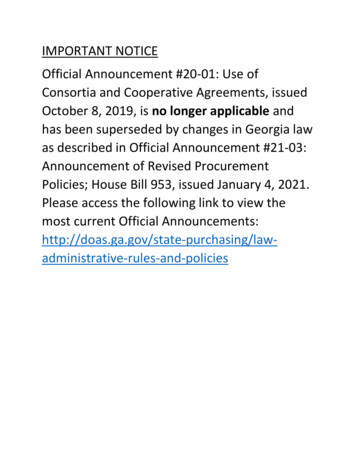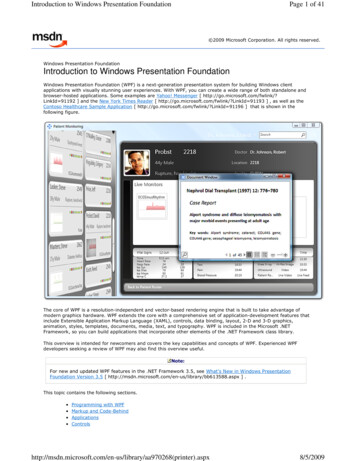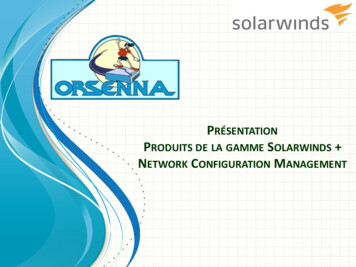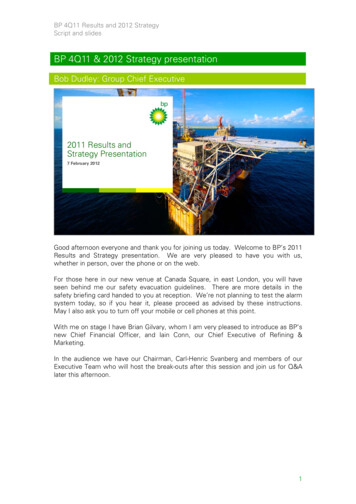
Transcription
PRELIMINARYANNOUNCEMENTAND PRESENTATION2012
Cautionary statement: All statements other than statements of historical fact included in thisdocument, including, without limitation, those regarding the financial condition, results, operationsand businesses of BAE Systems and its strategy, plans and objectives and the markets andeconomies in which it operates, are forward-looking statements. Such forward-looking statementswhich reflect management’s assumptions made on the basis of information available to it at this time,involve known and unknown risks, uncertainties and other important factors which could cause theactual results, performance or achievements of BAE Systems or the markets and economies in whichBAE Systems operates to be materially different from future results, performance or achievementsexpressed or implied by such forward-looking statements. BAE Systems plc and its directors accept noliability to third parties in respect of this report save as would arise under English law. Accordingly, anyliability to a person who has demonstrated reliance on any untrue or misleading statement or omissionshall be determined in accordance with schedule 10A of the Financial Services and Markets Act 2000.It should be noted that schedule 10A contains limits on the liability of the directors of BAE Systems plcso that their liability is solely to BAE Systems plc.
1BAE Systems Preliminary Announcement 2012RESULTS IN BRIEF AND FINANCIAL KEY POINTSResults in brief20122011 17,834m 1,895m 1,640m 19,154m 2,025m 1,580mn/a38.9p32.8p 42.4bn45.6p39.7p37.0p 39.1bn19.5p 2,692m 387m18.8p 634m (1,439)mResults from continuing operationsSales1Underlying EBITA2Operating profitUnderlying earnings3 per share:– including R&D tax benefit– excluding R&D tax benefitBasic earnings per share4Order backlog1,5Other results including discontinued operationsDividend per shareOperating business cash flow6Net cash/(debt) (as defined by the Group)7Financial key points– Sales1 reduced by 7%– Underlying EBITA2 reduced by 6% to 1,895m. Deferred recognition of sales and profit relating to theformalisation of price escalation on the Salam Typhoon programme– Underlying earnings3 per share down by 2% (excluding the benefit in 2011 of the UK tax settlement)– Order backlog1,5 increased by 8% to 42.4bn– Non-US and UK order intake1 increased to 11.2bn from 4.8bn in 2011– Total dividend increased by 4% to 19.5p– Operating business cash flow6 increased to 2.7bn– Net cash7 balance of 387m– Three-year share repurchase programme of up to 1bn initiated– Longevity risk on 2.7bn of pension scheme liabilities transferred to the insurance market1234567Including share of equity accounted investments.Earnings before amortisation and impairment of intangible assets, finance costs and taxation expense (EBITA) excluding non-recurring items (see page 6).Earnings excluding amortisation and impairment of intangible assets, non-cash finance movements on pensions and financial derivatives, and non-recurringitems (see note 4).Basic earnings per share in accordance with International Accounting Standard 33, Earnings per Share.Order backlog comprises funded and unfunded unexecuted customer orders, and is stated after the elimination of intra-group orders.Net cash inflow from operating activities after capital expenditure (net) and financial investment, dividends from equity accounted investments, and assetscontributed to Trust.See definition on page 7.
2BAE Systems Preliminary Announcement 2012OUTLOOKThis outlook statement assumes US budgets are subject to Continuing Resolution for the first quarter of 2013 only and does notreflect the impact that might result from a US sequestration.Subject to near-term uncertainties relating to US defence budgets, modest growth in underlying earnings3 per share is anticipated for2013. This excludes any benefit from the share repurchase programme in 2013. In addition, and assuming a satisfactory conclusion toSalam pricing negotiations this year, there would be a further increase of around 3 pence in underlying earnings3 per share.– Electronic Systems sales1 are expected to be at a similar level to those in 2012 with margins expected to be slightly lower within arange of 12% to 14%.– Cyber & Intelligence sales1 are expected to be marginally lower than those in 2012 with margins expected to be within an 8% to 9%range.– In Platforms & Services (US), Land & Armaments sales1 are expected to be approximately 10% below the 2012 level with marginsaround 8%. Support Solutions sales1 are expected to be marginally higher than in 2012, with slightly reduced margins.– Platforms & Services (UK) sales1 in 2013 are expected to increase by around 25%, assuming a price escalation settlement andresumption of aircraft deliveries on the Salam Typhoon contract. Margins are expected to be similar to those in 2012.– Platforms & Services (International) sales1 are expected to be marginally higher than in 2012. Margins are expected to benefit fromthe anticipated resolution of Salam Typhoon price escalation, and are expected to be at the top end of a 10% to 12% range.– HQ costs are expected to be more than 10% lower than in 2012 and Group earnings3 are expected to reflect marginally lowerunderlying finance costs. An effective tax rate within a 23% to 25% range is expected.Notwithstanding cash inflows from an anticipated Salam price escalation settlement, significant cash utilisation is expected in 2013.This includes an expected high level of utilisation against the advances, received in 2012, on the Saudi trainer aircraft and OmaniTyphoon and Hawk contracts and advances consumed on the European Typhoon production contracts.1 Including share of equity accounted investments.3 Earnings excluding amortisation and impairment of intangible assets, non-cash finance movements on pensions and financial derivatives, and non-recurringitems (see note 4).
BAE Systems Preliminary Announcement 20123PRELIMINARY RESULTS STATEMENTBAE Systems has continued to deliver on a clear strategy during 2012. The Group’s geographic breadth of business has provided,and is expected to continue to provide, resilience at a time when some of its markets are constrained by economic pressures.Following a period of growth, defence budgets in the US have flattened and are expected to remain constrained in response toreducing overseas operations and measures to address federal deficits. In the UK, the defence market has stabilised followingchanges to programme priorities outlined in 2010 through the UK government’s Strategic Defence and Security Review.Growth opportunities in some segments of the US and UK markets are identified, but the overall outlook in both countries is expectedto continue to be constrained.In wider international markets, the Group is seeing good growth in order intake leading to anticipated growth in international sales. In2012, order intake outside of the US and UK was 11.2bn, compared with 4.8bn in 2011.BAE Systems has a clear strategy, focused on enhancing its position as a premier global defence, aerospace and security company.Consistent with that strategy, discussions between BAE Systems and EADS were held between June and October of 2012. Thediscussions involved extensive engagement with many of the Group’s government stakeholders, including in the UK, US and SaudiArabia, and we were grateful for the positive support received. The merger would have been an exciting development, but no agreementacceptable to all parties could be reached.Focus on the underlying business performance was sustained as a priority while the merger discussions were underway. The Group’scontinued strategic aim is to drive shareholder value through a combination of meeting our customers’ requirements, furtherimprovements in financial performance and enhanced competitive positions across the business. The focus of the Group’s StrategicActions in pursuit of these goals includes: growth in its cyber, intelligence and security businesses; addressing growth opportunities inelectronic systems; driving further value from the Group’s broad base of platforms and services positions; and increased business ininternational markets outside of the UK and US.The evolution of BAE Systems has seen the Group’s business develop from an equipment supply-centred model to one that nowembraces a services culture. In 2012, 50% of the Group’s sales were generated in services across a wide range of activities andgeographies.Services activities include in-service support in the UK for the Royal Air Force’s trainer aircraft and fast jet fleets, and the Royal Navy’ssurface fleet. In Australia and Saudi Arabia, the Group provides a broadly-based range of support services to the armed forces.BAE Systems provides extensive support to US armed forces through provision of land vehicle reset and upgrade programmes, rotarywing and other aircraft support, and naval ship repair services. The Group also manages complex facilities including ammunitionproduction in the US and the UK.BAE Systems’ services activities also include the provision of extensive cyber and intelligence capabilities. The Group’s strategyincludes growing its positions in the cyber and intelligence services markets for governments, and pursuing organic growthopportunities in commercial cyber and security applications and systems.Affordability is a key consideration for all the Group’s customers and BAE Systems has been successful in reducing costs over asustained period. Whilst necessary to address lower demand in some business areas, cost reduction has also been targeted toachieve competitive advantage. A regrettable but unavoidable element of these cost reduction measures is the impact on employment.Excluding M&A activity, net employee headcount (including contractors) reduced by approximately 3,600 during the year, bringing thetotal net reduction across the past four years to approximately 26,000. In addition, site rationalisation has continued. These efficiencyimprovements lead to benefits for customers as well as underpinning the Group’s value proposition for shareholders.USBAE Systems’ business in the US contributed approximately 40% of Group sales in 2012. The US business has felt the dual pressureof reduced activity in support of deployed operations in Iraq and Afghanistan, and measures to reduce US federal budget deficits. Inparticular, the US land vehicles business has, as forecast, seen significant year-on-year reductions from the peak of activity in 2008.The US elections have introduced some additional defence procurement uncertainty with the administration entering a six-month periodof Continuing Resolution from the end of September 2012.Overhanging the US defence sector into 2013 is the potential impact of a sequestration or other budget reductions that could result inindiscriminate funding cuts. The Group bases its plans on conservative assumptions and continues to address its cost baseaccordingly.
4BAE Systems Preliminary Announcement 2012PRELIMINARY RESULTS STATEMENT (continued)UKDefence budgets in the UK are expected to remain flat, but the recent stabilising of equipment and services requirements and thebudget outlook has established a more predictable planning environment.The Group’s UK maritime business is experiencing a high level of activity. Growth is anticipated in the submarines business on theback of the multi-year Astute Class submarine programme and the build-up in engineering workload for the Successor programme.BAE Systems received further Successor funding during the year, with approximately 1,000 people now working on the programme.Also in the UK maritime business, the last ship of the six-ship Type 45 destroyer programme completed sea trials. Good progresscontinues to be made on the Queen Elizabeth Class Carrier programme with delivery of major blocks underway for the assembly of thefirst of these two ships. Work continues on the design of the Type 26 ships to replace the UK’s Type 23 frigates from early in the nextdecade. Type 26 production is expected to utilise a lower level of UK ship build capacity following the currently high levels on theCarrier programme. Discussions continue with the UK government to determine how best to sustain the capability to deliver complexwarships in the UK in the future.In the military air sector, European Tranche 2 Typhoon deliveries have continued and international prospects for Typhoon remain goodwith the potential to extend production into the next decade. The Group continues to deliver assemblies for the US-led F-35 Lightning IIprogramme under Low-Rate Initial Production contracts.InternationalIn addition to its US and UK operations, BAE Systems continues to build on its positions in international markets. As well asestablished operations in Saudi Arabia, Australia and more recently India, the Group is pursuing multiple new business opportunitiesworldwide.Defence remains a high priority in the Kingdom of Saudi Arabia. BAE Systems has a large involvement in the support of establishedRoyal Saudi Air Force (RSAF) and Royal Saudi Navy programmes in the Kingdom.Deliveries of RSAF Typhoon aircraft are contracted to recommence in 2013, following a contract amendment to enable UK finalassembly of the balance of 48 aircraft under the original contract for 72.Discussions to formalise Typhoon price escalation under the Salam programme remain ongoing.Discussions have commenced on the next phase of support, following on from the three-year agreement that formed part of thearrangements for initial entry into service of the Typhoon aircraft.Under the Saudi British Defence Co-operation Programme (SBDCP), orders totalling 3.4bn were awarded for support through to 2016,including the provision of manpower, logistics and training to the RSAF. In addition, a 1.6bn contract was awarded in May to supportthe RSAF’s future aircrew training requirements involving the supply of, and initial support for, Hawk Advanced Jet Trainer and Pilatustraining aircraft.BAE Systems is the leading provider of equipment and support to the Australian armed forces. The Group’s largest programme inAustralia is the Canberra Class programme to build two 27,000 tonne Landing Helicopter Dock vessels for the Royal Australian Navy.BAE Systems continues to develop its business in India. The Indian government has recently confirmed its intention to buy the M777artillery system and negotiations for a third batch of 20 locally assembled Hawk aircraft are expected to commence in 2013.In Oman, a 2.5bn contract for 12 Typhoon and eight Hawk aircraft and associated training and support has been awarded, and we areprogressing opportunities for Typhoon in Malaysia and the United Arab Emirates.In June, the business was awarded a 750m ( 462m) CV90 combat vehicle contract in Norway.
BAE Systems Preliminary Announcement 20125Balance sheet and capital allocationThe Group recognises the importance to investors of a clear capital allocation policy, consistent with sustaining a strong investmentgrade credit rating, as part of its value proposition.In addition to meeting its pension funding obligations, the Group expects to continue organic investment in its businesses to sustainand grow, plans to continue to pay dividends in line with its policy of a long-term sustainable cover of around two times underlyingearnings1 and to make accelerated returns of capital to shareholders when the balance sheet allows. Consistent with this approach, inFebruary 2013, the Group initiated a three-year share repurchase programme of up to 1bn. Full implementation of this programme issubject to satisfactory resolution of Salam Typhoon price escalation negotiations. Discussions with the Group’s UK pension schemetrustees have commenced to address any implications for deficit funding plans. Investment in value enhancing acquisitions willcontinue to be considered where market conditions are right, where they deliver on the Group’s strategy and where they offer greatervalue than repurchasing the Group’s own shares.M&A activityThe Group’s business portfolio is reviewed regularly to determine whether greater value can be created from the sale of a businessrather than its retention, and three small business disposals were made during the year for a combined consideration of approximately 111m.In March, the Group completed the sale of BAE Systems Safety Products Inc. and Schroth Safety Products GmbH (Safety Products). InJuly, the Safariland, LLC (Safariland) business and the assets comprising BAE Systems Tensylon High Performance Materials Inc.(Tensylon) were sold.BAE Systems continues to seek bolt-on acquisitions that enhance routes to market or which provide rapid access to relevanttechnologies and capabilities.In November, the Group agreed the acquisition of Marine Hydraulics International, Inc., a US marine repair, overhaul and conversioncompany, for cash consideration of approximately 69m ( 42m). The acquisition is expected to complete in the first quarter of 2013.Pension fundingTriennial funding valuations of the Group’s two largest UK pension schemes, the BAE Systems Pension Scheme and the BAE Systems2000 Pension Plan, were completed as at 31 March 2011. In 2012, agreement on revised deficit funding plans was reached with thetrustees of those schemes and the next valuation will commence in April 2014.Directors and managementIn May, Michael Hartnall, a non-executive director, stood down from the Board having served nearly nine years in that capacity.As previously announced, Sir Peter Mason stepped down as the Board’s Senior Independent Director in January 2013. Nick Rose, a nonexecutive director, succeeds Sir Peter as the Board’s Senior Independent Director. Sir Peter will step down from the Board at the AnnualGeneral Meeting in May 2013.In June, Tom Arseneault was appointed Executive Vice President of the Product Sector businesses headquartered in the US and ChiefTechnology Officer for BAE Systems, Inc. Also in June, Lynn Minella was appointed Group Human Resources Director following theretirement of Alastair Imrie. On their appointment, both Tom and Lynn joined the Group’s Executive Committee.With effect from 30 March 2013, Larry Prior, Executive Vice President of the Service Sector businesses headquartered in the US andChief Operating Officer for BAE Systems, Inc., and member of the Group’s Executive Committee, will leave the Group to pursue otheropportunities.In February 2013, David Herr was appointed Executive Vice President of the Service Sector businesses and joined the Group’s ExecutiveCommittee.DividendThe Board has recommended a final dividend of 11.7p per share making a total of 19.5p per share for the year, an increase of 4% over2011. At this level, the annual dividend is covered 2.0 times by underlying earnings1 (2011 2.1 times excluding the UK tax agreementbenefit).1Earnings excluding amortisation and impairment of intangible assets, non-cash finance movements on pensions and financial derivatives, and non-recurringitems (see note 4).
BAE Systems Preliminary Announcement 2012Cash flowReconciliation of cash inflow from operating activities4 to netcash/(debt) (as defined by the Group)2012 mCash inflow from operating activities42,916Capital expenditure (net) and financialinvestment(293)Dividends received from equity accountedinvestments94Assets contributed to Trust(25)Operating business cash flow2,692Interest(147)Income from financial assets at fair valuethrough profit or loss–Taxation(115)Free cash flow2,430Acquisitions and disposals96Purchase of equity shares (net)(16)Equity dividends paid(620)Dividends paid to non-controlling interests(11)Cash outflow from matured derivative financialinstruments(119)Movement in cash collateral(2)Movement in cash received on customers’account51Foreign exchange translation92Other non-cash movements(25)Total cash inflow/(outflow)1,826Opening net debt (as defined by the Group)(1,439)Closing net cash/(debt) (as defined by theGroup)3872011 2)(34)–13(20)36(1,197)(242)(1,439)Components of net cash/(debt) (as defined by the Group)2012 mDebt-related derivative financial assetsCash and cash equivalentsLoans – non-currentLoans and overdrafts – currentLess: Cash received on customers’ account5Less: Assets held in TrustLess: Cash held for charitable contribution toTanzaniaNet cash/(debt) (as defined by the Group)2011 3)–387(30)(1,439)Operating business cash flowElectronic SystemsCyber & IntelligencePlatforms & Services (US)Platforms & Services (UK)Platforms & Services (International)HQDiscontinued operationsOperating business cash flow2012 m2011 8)6347Cash inflow from operating activities4 was 2,916m (2011 951m), which includes down-payments received on newcontracts to Saudi Arabia and Oman, and contributions in excessof service costs for the UK and US pension schemes totalling 507m (2011 375m).The outflow from net capital expenditure and financial investmentof 293m (2011 268m) was only marginally higher than 2011.Dividends received from equity accounted investments, primarilyMBDA, Advanced Electronics Company, FNSS and Eurofighter,totalled 94m (2011 88m). This excludes a 424m non-cashspecial dividend received from MBDA during the year.Assets contributed to Trust comprise 25m of payments made intoTrust for the benefit of the BAE Systems 2000 Pension Plan. In2011, 137m was paid into Trust for the benefit of the Group’smain pension scheme.Taxation payments were 142m lower at 115m primarilyreflecting tax refunds following the 2011 UK tax settlement andtiming differences on UK and US tax payments, and reflect thelevel of pension deficit funding to the UK schemes.Net cash inflow in respect of acquisitions and disposals of 96mmainly comprises the disposals of Safety Products and Safariland,and assets comprising the Tensylon business. The prior yearoutflow of 256m mainly comprised the acquisition of L-1 IdentitySolutions, Inc.’s Intelligence Services Group, Norkom Group plc,ETI A/S, Fairchild Imaging, Inc. and stratsec.net Pty Limited( 524m), less the net proceeds from the disposal of the RegionalAircraft Asset Management business ( 98m) and the Group’sresidual shareholding in Saab AB ( 152m).The net purchase of equity shares of 509m in the prior yearincluded 184 million shares purchased under the buybackprogramme at a cost of 500m (excluding transaction costs of 3m).As a consequence of movements in US dollar and Euro exchangerates during the year, there has been a cash outflow from maturedderivative financial instruments of 119m (2011 34m) fromrolling hedges on balances with the Group’s subsidiaries andequity accounted investments.Foreign exchange translation primarily arises in respect of theGroup’s US dollar-denominated borrowing.Net cash (as defined by the Group) is 387m, a net inflow fromthe net debt position of 1,439m at the start of the year. Cashand cash equivalents of 3,355m (2011 2,141m) are heldprimarily for pension deficit funding, payment of the 2012 finaldividend, the share repurchase programme and management ofworking capital.In June 2012, the Group issued a 400m, ten-year bond with anannual coupon of 4.125% intended for general corporatepurposes, including the repayment of debt securities at maturityin 2014.12345Including share of equity accounted investments.Earnings before amortisation and impairment of intangible assets, financecosts and taxation expense (EBITA) excluding non-recurring items.Earnings excluding amortisation and impairment of intangible assets, non-cashfinance movements on pensions and financial derivatives, and non-recurringitems (see note 4).Excludes the 428m contribution from Trust to the UK pension schemes andthe 29.5m charitable contribution for the benefit of the people of Tanzaniain connection with the global settlement with the UK’s Serious Fraud Office in2010, both made in 2012, as the amounts had been deducted from theGroup’s net cash/(debt).Cash received on customers’ account is the unexpended cash received fromcustomers in advance of delivery which is subject to advance paymentguarantees unrelated to Group performance. It is included within trade andother payables in the consolidated balance sheet.
8BAE Systems Preliminary Announcement 2012REPORTING SEGMENTS: ELECTRONIC SYSTEMSElectronic Systems, with 13,000employees1, comprises the US and UK-basedelectronics activities, including electronicwarfare systems and electro-optical sensors,military and commercial digital engine andflight controls, next-generation militarycommunications systems and data links,persistent surveillance capabilities, andhybrid electric drive systems.– Sustained a leadership position in the airborne electronicwarfare marketUnderlying EBITA2 was 356m (2011 386m). Return on saleswas 14.2% (2011 14.6%).Following severe flooding in September 2011, operations formerlyconducted at the Electronic Systems facility in Johnson City, NewYork, have been moved to Endicott, New York. After a year ofrecovery efforts, operational capability has been restored andprogrammes are back on schedule.– Won key development contracts in the classified area– Continued focus on increasing productivity and efficiency– Business recovery complete following disruption from flooddamage at the Johnson City facility– 0.2bn of research and development expenditure5 in 2012Financial key points– Underlying order backlog1,4 increased in challenging businessenvironment– Sales1 reduction from operational tempo-driven activity onThermal Weapon SightsElectronic Combat The business maintains its leadership positionin the electronic warfare market, with continued focus on the F-35Lightning II Systems Design and Development programme,planning for the flight test programme starting in 2013. Thebusiness progressed Low-Rate Initial Production (LRIP) Lot 5 and6 deliveries during the year, and has responded to the LRIP Lot 7request for proposal, which includes production aircraft forinternational customers.In support of the US Navy’s Next-Generation Jammer, which willreplace the ageing jammer currently on certain US Navy aircraft, a 20m ( 12m) modification was received to expand the scope ofthe existing technology maturation contract. BAE Systems is oneof three bidders on the next phase technology developmentcontract valued at approximately 300m ( 185m).– Return on sales of 14.2%– Cash flow3 conversion of underlying EBITA2 at 95%, beforepension deficit funding2011On a like-for-like basis, sales1 reduced by 7% on 2011 primarilyreflecting the completion of deliveries of Thermal Weapon Sightsas operational tempo-driven activity reduces. Sales in theCommercial Aircraft electronics business increased by 11%.Operational performance– Strengthened position in high growth commercial aircraftelectronics market2012Order backlog1,4, excluding the impact of US dollar exchangetranslation, increased despite the impact of contracting delays asthe US administration operated federal budgets under ContinuingResolution limitations.Cash flow3 conversion of underlying EBITA2 was 95%, beforepension deficit funding.Operational key pointsFunded order intake1Order backlog1,4Sales1Underlying EBITA2Return on salesCash inflow3Financial performance2010 2,540m 2,620m 2,894m 3.6bn 3.6bn 3.5bn 2,507m 2,645m 2,969m 356m 386m 455m14.2%14.6%15.3% 256m 268m 367mThe Digital Electronic Warfare System (DEWS) continues to securenew contract awards, including a six-year, 0.4bn ( 0.2bn)contract to upgrade 70 F-15 aircraft for the Royal Saudi Air Force.Initial flight testing providing advanced radar warning andcountermeasure capabilities is scheduled to begin in March 2013.The business continues to pursue other export opportunities forthe DEWS suite.Also in international markets, the business received threecontracts totalling 86m ( 53m) to provide F-16 supportequipment, test systems and spares to the governments of Oman,Indonesia and Iraq for delivery by early 2014.Survivability & Targeting In early 2012, the US Army awarded thebusiness a two-year, 38m ( 23m) contract to develop theCommon Infrared Countermeasures capability. Using itsBoldstroke system, an integrated aircraft survivability system forprotecting aircraft from infrared-guided missiles and other threats,the business will provide increased system capability in a smaller,more energy efficient package. Following a competitor protest, theaward was upheld by the US Government Accountability Office andwork restarted in June. Initial test systems are in progress, withthe first units scheduled for government acceptance ahead ofschedule.12345Including share of equity accounted investments.Earnings before amortisation and impairment of intangible assets, finance costs and taxation expense (EBITA) excluding non-recurring items (see page 6).Net cash inflow from operating activities after capital expenditure (net) and financial investment, dividends from equity accounted investments, and assetscontributed to Trust.Comprises funded and unfunded unexecuted customer orders.Includes both Group-funded and customer-funded expenditure.
BAE Systems Preliminary Announcement 2012The Advanced Precision Kill Weapon System programme passedtests on several airborne platforms. With deployment in theatreand positive performance feedback, the US Navy has authorisedFull-Rate Production of the system and awarded a base contractvalued at 28m ( 17m) for 985 units and a Full-Rate Productionoption of 41m ( 25m) for 1,476 units.Under a 37m ( 23m) subcontract, BAE Systems continues tosupport the engineering and manufacturing development of theJoint and Allied Threat Awareness System, a next-generationwarning system to enhance aircraft survivability for the US Navy.The Thermal High-Altitude Area Defence seeker programmeprovides a transportable, rapidly deployable, ground-basedcapability to i
- Underlying earnings3 per share down by 2% (excluding the benefit in 2011 of the UK tax settlement) - Order backlog1,5 increased by 8% to 42.4bn - Non-US and UK order intake1 increased to 11.2bn from 4.8bn in 2011 - Total dividend increased by 4% to 19.5p - Operating business cash flow6 increased to 2.7bn










